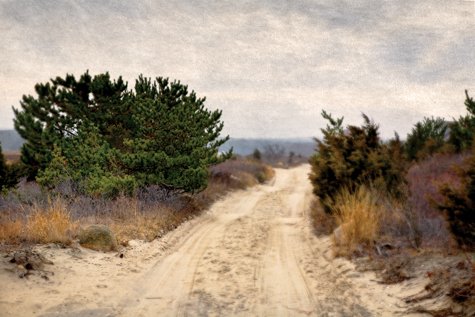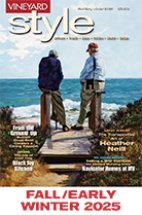ARTIST PROFILE

The Interpretive Photography of
Michael Stimola
Profile by Karla Araujo
While some fine art photographers are content to capture the world around them exactly as they see it through the eye of the camera, Michael Stimola prefers a less literal approach. He uses multiple images – layering an initial photograph with scans of found or fabricated materials – to create wholly unique interpretations of diverse environments and the objects that inhabit them.
Maintaining what he calls a “sketchbook” of small scanned images, from old papers and cloth to leather and ground stone, Michael melds them with digital photographs to infuse texture and mood. The result: a distinctive and painterly portfolio that reflects a masterful blend of classic composition and contemporary manipulation.
Though he dabbled in photography for many years, it wasn’t until he neared retirement from his forty-year career in higher education that Michael turned his passion into something nearer a profession. Largely self-taught, he took courses from 2002 to 2007 at the School of Visual Arts and at the International Center of Photography, both in New York City.
The recipient of awards at the Martha’s Vineyard Agricultural Fair and the Martha’s Vineyard All Island Art Show, as well as from Color and Black & White magazines, Michael has also shown his work at Dragonfly Gallery and at Featherstone Center for the Arts in Oak Bluffs. His Martha’s Vineyard photographs are currently represented exclusively by The Field Gallery in West Tisbury.
A resident of West Tisbury and Edgewater, NJ, he and his wife, Rosemary, owner of a literary agency, have made their part-time home on the Island since 1988. “The Vineyard is a magical place,” he says. “We’ve been coming here for more than thirty years, so the Island is suffused with memories and feelings. I try to impart those emotional responses to the images I shoot.”
Because his camera accompanies him wherever he goes, Michael’s portfolio is composed of photographs from the Vineyard, New York City, Europe, and the Meadowlands, an industrial area of northeast New Jersey where he became fascinated by the blighted terrain. Working primarily in color, most of Michael’s images utilize his layering technique to impart mood, texture or nuance. The Field Gallery exhibits his Vineyard images only; Michael’s other portfolios are viewable on his website.
Jennifer Pillsworth, The Field Gallery director and a professional photographer herself, believes that Michael’s acute sensitivity to the world around him comes from his decades as a counselor, dealing, she says, “with other people’s perceptions.”
“That sensitivity comes through his work – it’s refreshing, unique,” she suggests. “People seem to relate strongly to his sense of place in his Island landscapes.”
Jennifer, who calls herself “an old school analog dinosaur “ when it comes to camera technology, characterizes Michael’s work as “fresh, what’s happening now.” While she finds a great deal of digital photography simply manipulative rather than artistic, she describes Michael’s approach as derivative of traditionalists like Ansel Adams.
“He paints with light like Ansel Adams,” she explains. “Just not in the darkroom. With so much digital work, you see only the manipulation. Michael’s work is a delicate balance. He’s using the magic that digital can offer.” With price points on his photographs that make them accessible to many patrons, Jennifer says that he is attaining an enthusiastic following at the gallery.
This summer, a new collection of approximately a dozen of his Vineyard photographs, some of them printed on aluminum sheets, will be featured in a show with botanical oil paintings by Anne Salas. The opening reception for the two-week exhibition is scheduled at The Field Gallery for Sunday, August 19, from 5 to 7pm.
According to Michael, photography served as means to balance the stress from his profession as a counselor and director of programs for students with disabilities at Hostos Community College in the South Bronx. Although he loved his work, by 2010, nearly four decades after entering his career, he was ready for a change. At the urging of his sister, Kathleen Anderson, an instructor at the International Center of Photography, Michael embraced his avocation with renewed ardor. After several years of classes, he decided to focus on producing his work independently.
“Schools can be constraining,” he explains. “It was time for self-education. I had to work on my own to discover how to say what I wanted to say.”
Although he had tried to pursue photography, including his own darkroom work, in the 1980s, Michael found that the chemicals made him extremely ill. The digital revolution was liberating, allowing him to use the new digital technology and his computer skills to alter images without darkroom techniques like dodging, burning or vignetting.
“I had always admired the photographers of the Pictorialist and Photo-Secession movements,” Michael says, with a nod to the early twentieth century schools that emphasized the beauty, tonality and composition of an image rather than the documentation of reality. And, while he cites landscape photographers Ansel Adams and Eliot Porter as early influences, he points to the work of contemporary photographers Marc Yankus of New York City and Jack Spencer of Nashville, as important shapers of his own aesthetic and vision.
“I’ve also intrigued by the painters of the late 1800s and early 1900s, as well as photographers [Edward] Steichen, [Alfred] Stieglitz and [Clarence H.] White,” Michael says, admiring the “moody, abstracted, emotional quality” of their works.
Citing painter Edward Hopper as a final significant influence and noting his “melancholy, strong use of shadow and light, and diagonal lines,” Michael respects Hopper’s outsider status. “In his time he didn’t belong to a school,” he explains. “I’m not a school kind of person. I’m trying to figure out what works for me.”
While the breadth of his work demonstrates his wide range of interests, Michael clearly states his overriding philosophy on his website: “I see my photographs as explorations of relationships – relationships between the subject seen through the lens and the reservoir of memories and associations I have with it, shaped by personal experience and inspired by the work of artists and writers.”
Living on the Island continuously from late spring through the fall, Michael also makes monthly forays to West Tisbury throughout the year, with seasonal elements apparent in his work. As part of the Vineyard arts community, Michael says he owes a great debt to supporters Holly Alaimo, former owner of Dragonfly Gallery and to photographer and gallery owner Alison Shaw, both of Oak Bluffs. He also credits a long roster of other Island artists including Allen Whiting, David Wallis, Kara Taylor, Michael Zide and Janet Woodcock with inspiring him to capture the beauty of nature in his own work.
“The Island is so rich with talent,” says Michael. “Every artist contributes to the vocabulary we use to capture our environment.” Toting his Canon 5D Mark III, he explores the Island regularly with friend and fellow photographer Hank Gans and thanks fishing buddies like Bob Lane of Oak Bluffs for calling in tips on don’t-miss settings. Some of his favorite haunts for shooting: Duarte’s Pond, Blackwater Pond Reservation, Hoft Farm Preserve, Nat’s Farm, Makonikey, and Long Point Wildlife Refuge, all in West Tisbury, as well as Philbin Beach in Aquinnah.
With his second career flourishing, Michael is quick to offer these words to anyone toying with the pursuit of a long-simmering passion: “It’s so much fun doing this! Be open. If you have an interest, pursue it. Take courses, find a mentor, ask for help.”
To see more of Michael Stimola’s Vineyard photography, visit The Field Gallery online at www.fieldgallery.com, or stop by at 1050 State Road, West Tisbury. Exhibition scheduled for August 19-September 1, 2012 with cocktail reception August 19, 5-7pm. To view Michael’s other portfolios, visit michaelstimolaphotography.com.
Maintaining what he calls a “sketchbook” of small scanned images, from old papers and cloth to leather and ground stone, Michael melds them with digital photographs to infuse texture and mood. The result: a distinctive and painterly portfolio that reflects a masterful blend of classic composition and contemporary manipulation.
Though he dabbled in photography for many years, it wasn’t until he neared retirement from his forty-year career in higher education that Michael turned his passion into something nearer a profession. Largely self-taught, he took courses from 2002 to 2007 at the School of Visual Arts and at the International Center of Photography, both in New York City.
The recipient of awards at the Martha’s Vineyard Agricultural Fair and the Martha’s Vineyard All Island Art Show, as well as from Color and Black & White magazines, Michael has also shown his work at Dragonfly Gallery and at Featherstone Center for the Arts in Oak Bluffs. His Martha’s Vineyard photographs are currently represented exclusively by The Field Gallery in West Tisbury.
A resident of West Tisbury and Edgewater, NJ, he and his wife, Rosemary, owner of a literary agency, have made their part-time home on the Island since 1988. “The Vineyard is a magical place,” he says. “We’ve been coming here for more than thirty years, so the Island is suffused with memories and feelings. I try to impart those emotional responses to the images I shoot.”
Because his camera accompanies him wherever he goes, Michael’s portfolio is composed of photographs from the Vineyard, New York City, Europe, and the Meadowlands, an industrial area of northeast New Jersey where he became fascinated by the blighted terrain. Working primarily in color, most of Michael’s images utilize his layering technique to impart mood, texture or nuance. The Field Gallery exhibits his Vineyard images only; Michael’s other portfolios are viewable on his website.
Jennifer Pillsworth, The Field Gallery director and a professional photographer herself, believes that Michael’s acute sensitivity to the world around him comes from his decades as a counselor, dealing, she says, “with other people’s perceptions.”
“That sensitivity comes through his work – it’s refreshing, unique,” she suggests. “People seem to relate strongly to his sense of place in his Island landscapes.”
Jennifer, who calls herself “an old school analog dinosaur “ when it comes to camera technology, characterizes Michael’s work as “fresh, what’s happening now.” While she finds a great deal of digital photography simply manipulative rather than artistic, she describes Michael’s approach as derivative of traditionalists like Ansel Adams.
“He paints with light like Ansel Adams,” she explains. “Just not in the darkroom. With so much digital work, you see only the manipulation. Michael’s work is a delicate balance. He’s using the magic that digital can offer.” With price points on his photographs that make them accessible to many patrons, Jennifer says that he is attaining an enthusiastic following at the gallery.
This summer, a new collection of approximately a dozen of his Vineyard photographs, some of them printed on aluminum sheets, will be featured in a show with botanical oil paintings by Anne Salas. The opening reception for the two-week exhibition is scheduled at The Field Gallery for Sunday, August 19, from 5 to 7pm.
According to Michael, photography served as means to balance the stress from his profession as a counselor and director of programs for students with disabilities at Hostos Community College in the South Bronx. Although he loved his work, by 2010, nearly four decades after entering his career, he was ready for a change. At the urging of his sister, Kathleen Anderson, an instructor at the International Center of Photography, Michael embraced his avocation with renewed ardor. After several years of classes, he decided to focus on producing his work independently.
“Schools can be constraining,” he explains. “It was time for self-education. I had to work on my own to discover how to say what I wanted to say.”
Although he had tried to pursue photography, including his own darkroom work, in the 1980s, Michael found that the chemicals made him extremely ill. The digital revolution was liberating, allowing him to use the new digital technology and his computer skills to alter images without darkroom techniques like dodging, burning or vignetting.
“I had always admired the photographers of the Pictorialist and Photo-Secession movements,” Michael says, with a nod to the early twentieth century schools that emphasized the beauty, tonality and composition of an image rather than the documentation of reality. And, while he cites landscape photographers Ansel Adams and Eliot Porter as early influences, he points to the work of contemporary photographers Marc Yankus of New York City and Jack Spencer of Nashville, as important shapers of his own aesthetic and vision.
“I’ve also intrigued by the painters of the late 1800s and early 1900s, as well as photographers [Edward] Steichen, [Alfred] Stieglitz and [Clarence H.] White,” Michael says, admiring the “moody, abstracted, emotional quality” of their works.
Citing painter Edward Hopper as a final significant influence and noting his “melancholy, strong use of shadow and light, and diagonal lines,” Michael respects Hopper’s outsider status. “In his time he didn’t belong to a school,” he explains. “I’m not a school kind of person. I’m trying to figure out what works for me.”
While the breadth of his work demonstrates his wide range of interests, Michael clearly states his overriding philosophy on his website: “I see my photographs as explorations of relationships – relationships between the subject seen through the lens and the reservoir of memories and associations I have with it, shaped by personal experience and inspired by the work of artists and writers.”
Living on the Island continuously from late spring through the fall, Michael also makes monthly forays to West Tisbury throughout the year, with seasonal elements apparent in his work. As part of the Vineyard arts community, Michael says he owes a great debt to supporters Holly Alaimo, former owner of Dragonfly Gallery and to photographer and gallery owner Alison Shaw, both of Oak Bluffs. He also credits a long roster of other Island artists including Allen Whiting, David Wallis, Kara Taylor, Michael Zide and Janet Woodcock with inspiring him to capture the beauty of nature in his own work.
“The Island is so rich with talent,” says Michael. “Every artist contributes to the vocabulary we use to capture our environment.” Toting his Canon 5D Mark III, he explores the Island regularly with friend and fellow photographer Hank Gans and thanks fishing buddies like Bob Lane of Oak Bluffs for calling in tips on don’t-miss settings. Some of his favorite haunts for shooting: Duarte’s Pond, Blackwater Pond Reservation, Hoft Farm Preserve, Nat’s Farm, Makonikey, and Long Point Wildlife Refuge, all in West Tisbury, as well as Philbin Beach in Aquinnah.
With his second career flourishing, Michael is quick to offer these words to anyone toying with the pursuit of a long-simmering passion: “It’s so much fun doing this! Be open. If you have an interest, pursue it. Take courses, find a mentor, ask for help.”
To see more of Michael Stimola’s Vineyard photography, visit The Field Gallery online at www.fieldgallery.com, or stop by at 1050 State Road, West Tisbury. Exhibition scheduled for August 19-September 1, 2012 with cocktail reception August 19, 5-7pm. To view Michael’s other portfolios, visit michaelstimolaphotography.com.








